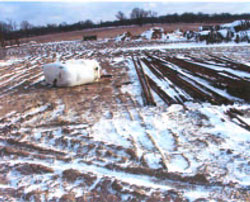
Investigation: # 02MI029
Farmer Died After Being Struck While Seated On The Tractor By an Unrestrained Rectangular Haylage Bale That Fell Out of An Elevated Front-End Loader Bucket That Independently Elevated
 |
| Figure 1. Overview of incident layout and terrain |
RECOMMENDATIONS
INTRODUCTION
On March 10, 2002, a 52-year-old male farmer who raised buffalo died when an unsecured 1500-pound haylage bale fell out of a tractor’s front-end loader bucket and struck him. MIFACE investigators were informed of this work-related death from a newspaper article. On November 19, 2003 MIFACE researchers visited the buffalo farm and spoke with the victim’s wife and daughter and viewed the tractor/front-end loader involved in the incident. Also present during the MIFACE visit to the farm was a representative of the company that was selected to place a new joystick control mechanism on the tractor. During the course of writing the report, the death certificate, police report, and police pictures taken at the incident scene were obtained. The victim’s wife provided MIFACE the hospital record for review since an autopsy was not performed. Figure 2 and Figures 7-13 were taken by the MIFACE researcher during the site visit. Figure1 and Figures 3-6 were taken by the responding police agency.
The victim and his wife started their buffalo farm ten years ago. The victim also planned to incorporate a buffalo meat-cutting and sales business. He was the owner of the farm and also managed a private residential community development. He had been farming for 10 years was very familiar with operating the tractor. There were 56 head of buffalo at the farm and the buffalo were fed hay. The victim had another 40 acres of land designated for expansion of the business and also rented 40 acres to another individual. The farm did not have a written health and safety program. Metal pipes were used to build the corral enclosing the buffalo.
INVESTIGATION
The tractor involved in the fatality was a late 1960’s model, 2-wheel drive, Ford 4000 tractor. The tractor did not have an enclosed cab. The victim’s wife stated that the tractor tires were not filled with chloride (they were unweighted) and that there were no additional rear counterweights. MIFACE investigators also noted that the power take-off shaft was unshielded.
The tractor was equipped with an aftermarket Koyker brand front-end bucket loader. The victim bought the new Koyker 210 front-end loader as an aftermarket attachment eight months prior to the incident. The local tractor dealership installed the loader. The victim had been operating the front-end loader equipped tractor for eight months and was familiar with its operation. The loader bucket was a general-purpose bucket and was not designed for handling large square bales. The bucket did not have any mechanism (grapple fork or bale spear) to securely hold the bale while it was being transported. (See Figure 6) The loader was equipped with a quick-attach five-foot bucket. The loader’s lift capacity was 2750 pounds. The victim had not overloaded the bucket carrying one 1500-pound haylage bale.
The victim controlled the loader’s arm and bucket movement by the use of a joystick. See Figure 2. Moving the joystick up and down raised and lowered the loader arms. Moving the joystick side to side tilted the bucket.
The ground surface conditions on the day of the incident contributed to the fatality. According to the Record of Climatological Observations at the Lapeer WWTP station from the National Weather Service, several days of above freezing temperatures occurred prior to March 11 that caused freeze/thaw conditions at the ground surface. March 7 and 8 high temperatures were 37 degrees and 35 degrees respectively. On March 9, two days before the incident, the temperature reached nearly 60 degrees. It was raining, and the snow that had fallen two days before melted. During the early morning on March 10, the two inches of snow fell. As temperatures increased, the snow changed to rain. The high temperature on March 10 was again nearly 60 degrees, causing muddy conditions. The temperature fell on the night of March 10; one inch of snow fell and a maximum temperature of 22 degrees was reached on March 11. Operating the loader repeatedly over these days in this area contributed to the rutted conditions seen in Figure 3. The police report stated that the winds were strong from the west, and there was less than one inch of snow on the ground. The Record of Climatological Observations did not have any wind speeds recorded for this weather station.
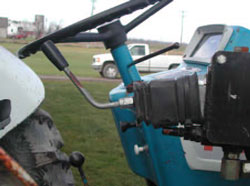 |
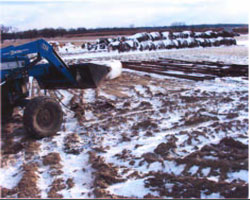 |
|
Figure 2. Joystick control operating front-end loader |
Figure 3. Ground conditions and moved tractor after
the incident |
The victim’s wife stated that when the loader was used to transport haylage and hay for long distances, the victim routinely secured the hay bale inside of the bucket with a chain. But, when transporting the bales short distances, the victim did not routinely secure the hay bale with a chain in the bucket. Confirming the wife’s statement, Figure 6 taken by the police at the time of the incident shows a loose chain hanging inside of the bucket. She also noted that the victim always traveled with the bucket low to the ground. On the day of the incident, the victim was transporting one four-foot by five-foot plastic-covered square haylage bale a short distance to his wife. His wife was standing by the buffalo pen using a pitchfork to feed the buffalo. She was finishing a bale that was used the day before while he drove the tractor to retrieve and transport the first bale to her.
The victim kept his plastic-covered haylage bales in rows near the barn and the buffalo pen. The buffalo pen was located behind the barn. To the west of the buffalo were the bales and metal pipes running in a north and south direction. Tracks in the snow indicate the victim was driving the tractor facing west to southwest. See Figure 3.
The victim’s wife stated that the victim had twisted to look toward the
rear of the tractor in her direction while backing up with the hay bale in the
bucket in a low position, approximately three to four feet off of the ground.
The rear wheels rolled into a depression and became stuck. The police report
states that the left front tractor tire was directly on the ground and the right
front tractor tire was on the metal pipes. See Figure
4 for the right front tire mark on the metal pipes.
The victim attempted to free his stuck tractor. His wife stated she watched
him rock the tractor back and forth. The victim’s wife originally thought
that the victim had raised the loader bucket over the hood of the tractor to
change the tractor’s center of gravity and “give the rear wheels
more weight”. During the rocking movement, the hay bale fell out of the
elevated bucket and struck the victim on the right side of his head and chest.
The 1500-pound bale bounced off of the victim and landed on the ground to the
victim’s left. The victim remained seated in the tractor with his hands
on the steering wheel and his foot stuck under the brake pedal
When the bale struck the victim, the weight and force of the bale caused the tractor seat to twist down from right to left. The steering wheel was also bent downward right to left as a result of being struck by either the victim or the bale. See Figure 5.
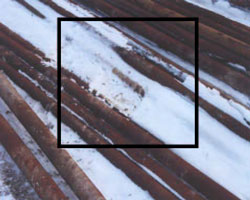 |
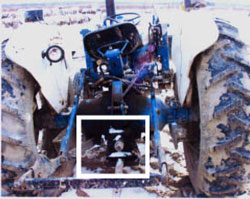 |
|
Figure 4. Mark of right front tractor wheel on metal
pipes |
Figure 5. Bent steering wheel and tractor seat. Note
unguarded tractor PTO stub |
The victim’s wife ran to his side. When the bale struck the victim, it activated his cell phone to redial the last phone number he had called. This phone number was to her daughter. She answered, heard her mother yelling, and went to the scene. She called her husband who came over to the incident site. At first, they left the victim on the tractor seat because they were afraid to move him. When the victim started turning “blue”, the family took him down from the tractor seat and began CPR. Emergency response was called and arrived at the scene. The victim was transported to a local hospital where he was declared dead.
The police found the tractor with the loader’s arms elevated and moved the tractor to another location. They set the bucket a few feet off of the ground, turned the tractor off and took the keys. See Figure 6.
After she returned from the hospital that evening, the victim’s wife wanted to place the tractor into the barn for storage She started the tractor and was backing up. Her daughter, who was assisting her, told her to stop, as the bucket was in the air. The victim’s wife had not touched the joystick mechanism. She lowered the loader bucket to the ground and turned off the tractor. When she turned the tractor on, the loader bucket elevated again without her touching the joystick.
The next day, she spoke with the tractor dealership about the problem. The dealership representative told her to tighten the setscrew that controlled the loader’s hydraulics. She found that after removing the protective cover that the setscrew had loosened over time. The loosening of the setscrew permitted the loader’s arms to rise independently without touching or operating the control valve. She stated that prior to the day of the incident, the loader arms had not elevated independently.
She tightened the setscrew and that resolved the independent loader arm movement for a few months. After a few more months use, the setscrew loosened again and the loader arms raised independently. The setscrew, according to victim’s wife has loosened an additional two times. Each time she tightened the setscrew resolving the problem and continued to use the tractor.
On the day of the MFACE visit, the setscrew again needed adjustment and the victim’s wife demonstrated how the bucket independently elevated when she started the tractor. The MIFACE investigators and the representative of the company selected to replace the joystick observed the loader arms raise without the victim’s wife touching the loader’s joystick when she turned on the tractor. The victim’s wife removed the cover and demonstrated how the dealership recommended she fix the setscrew. Figure 7 is a picture of the setscrew arrangement. The victim’s wife kept the tractor until the MIFACE visit. She planned to sell the tractor after the joystick replaced by the joystick manufacturer’s representative.
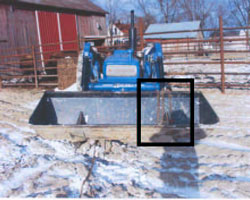 |
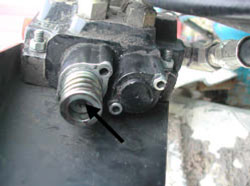 |
| Figure 6. Moved
tractor with bucket in semi-raised position and loose chain |
Figure 7. Setcrew controlling
hydraulic valve |
CAUSE OF DEATH
The cause of death as listed by the medical examiner on the death certificate was death by multiple traumatic injuries. No toxicological tests were performed.
RECOMMENDATIONS/DISCUSSION
The unsecured bale of haylage is the underlying cause of this tragic work-related death. Even though the loader’s arms elevated independently due to the loosened set screw, if the hay bale had been adequately secured inside of the bucket by a manufacturer’s approved restraining device, the bale would not have fallen on the victim. According to the manufacturer’s literature or sources, this particular after-market product offered a grapple device to secure in place objects such as large bales. The literature or operator’s manual for the front-end loader stating the loader’s intended uses or misapplications of use was not available. These attachments hold the bale in a secure stable position as it is raised, lowered or being transported. When traveling longer distances, the victim’s wife stated that the victim routinely secured the hay in the loader bucket with chains and traveled with the load near to the ground, but he did not routinely secure the load in the bucket when traveling short distances. Chains may not provide adequate load restraint.
Moving the bale with a tractor equipped with a front-end loader that did not have a grapple to secure the bale was a contributing cause of the fatal incident. The use of the front-end loader without a grapple as a means for handling the large square hay bale presented a hazard, particularly when the loader arms raised independently above the front end of the tractor. A front-end loader equipped with a grapple, designed for the task being performed by the operator would have provided a safe means for handling the hay with less risk to the operator. After the incident, the loader bucket was equipped with a bale spear. See Figure 8. The spear attachment is not normally designed nor intended for use with square bales.
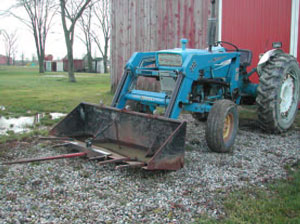 |
|
Figure 8. Bale spear attachment to loader bucket |
The operator was operating a two-wheel drive tractor loader over frozen, rutted,
snow-covered ground, thereby decreasing the vehicle’s control and maneuverability.
An inspection of the area and consequent identification and control of the hazards,
such as selection of an alternate path or building an improved road-bed pathway
to the feeding area may have prevented the tractor’s rear wheels from
becoming lodged in a rut and causing the victim to rock the tractor to free
it.
A 4-wheel drive tractor offers improved control and traction. The victim was driving a 2-wheel drive tractor. A 2-wheel drive tractor needs 80% of the weight distributed over the rear axle to maximize traction. The addition of the front-end loader alters the weight distribution and the tractor’s center of gravity, thus altering a 2-wheel drive tractor’s ability to work in wet and/or muddy conditions. A 4-wheel drive tractor needs 60% of the weight distributed over its rear axle and has better traction in muddy or wet conditions.
The tractor used during this incident was not equipped with any type of enclosed rollover protective structure (ROPS). A front-end loader affects a tractor’s stability. When a loader’s arms are raised, this significantly alters the tractor’s center of gravity, thereby decreasing the machine’s traction and maneuverability and increases the risk of a tractor rollover or displacement of the load. Therefore, tractors equipped with a front-end loader should have a rollover protective structure, specifically a ROPS cab, and a seat belt. If the tractor had been equipped with an enclosed rollover protective structure, the bale might have been deflected as it tumbled toward the victim. If the bale had not directly struck the victim, he may not have been injured or may have been less severely injured and this fatality might have been prevented.
When using a tractor equipped with a front-end loader, extra weight should
be added onto the rear of the tractor to counter-balance the weight of the front-end
loader and the load being transported. Counterweights ease the load on the front
axle and give increased ground traction on the rear of the tractor while using
the front-end loader to lift or transport a load or while loading the bucket.
Counterweights also help with braking and traction with a load in the loader.
Weighted rear tires provide weight to the rear axle that is wide and low, which
improves stability. Check the operator’s manual for specific recommendations.
When performing maintenance or service on the tractor, the manufacturer’s maintenance schedule should be followed. Additionally, the hydraulic filter on the tractor should be changed. It is unknown whether the tractor’s hydraulic filter was replaced when the tractor dealership installed the loader. Another unknown is whether the dealership drained and added new hydraulic fluid to the tractor or just “topped off” the hydraulic fluid reservoir. MIFACE suggests that equipment owners consider that when installing aftermarket accessories that function via the tractor’s hydraulics, that the tractor’s hydraulic fluid filter (if equipped) be replaced, the existing hydraulic fluid drained, and fresh hydraulic fluid added. Following these recommendations will minimize the possibility of operating the tractor with hydraulic fluid that may be contaminated, whether by preexisting contamination or contamination that may occur during accessory installation. Uncontaminated hydraulic fluid is essential for proper hydraulic control valve functioning.
After installation of any manufacturer approved tractor accessory, the full
range of movement of the accessory should be tested to ensure all hydraulic
connections have been properly replaced, and the hydraulic fluid is throughout
the system without air entrapment. The loader should be operated through its
full range of motion: fully raise and lower the loader arms and tilt and return
the bucket to its neutral position. This test will remove any air that may have
been trapped in the system during installation and will avoid unexpected erratic
movement during use.
The joystick control valve has a setscrew that regulates the hydraulic component of the front- end loader. The setscrew tightens the spring centering mechanism that keeps the loader in a neutral position. The setscrew does not have a lock washer or other mechanism to keep it in place. During use, this setscrew loosens. The spring centering mechanism allows the hydraulic fluid to be pumped to the loader’s arms resulting in the loader’s arms elevating.
If approved by the manufacturer, a threadlocker compound (an adhesive that cures in the absence of air) could be used on the setscrew to limit its movement without constant tool adjustment.
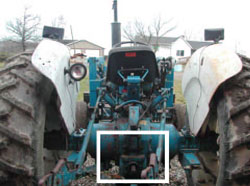 |
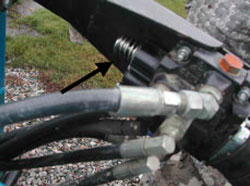 |
|
Figure 9. Exposed PTO shaft |
Figure 10. Hydraulic control setscrew location |
Exposed rotating shafts are hazardous situations that can cause serious injury. A PTO operating at 540 rpm rotates around 9 times/second. It takes only about one second to completely strip off an article of clothing or if the cloth does not tear away, and to wrap a body or body part around a shaft. Clothing is pulled around the shaft much quicker than a person can pull back or take evasive action. Even a quick reaction time, one-half of a second, would permit a piece of clothing to wrap around a shaft rotating at 540 rpm at least two times.
A total shielding system for a PTO driveline includes a tractor stub master shield, the PTO driveline shield and an implement shield. The master shield prevents the operator from accidentally coming into contact with the tractor stub shaft. Figure 5 and Figure 9 show the unguarded PTO shaft.
Most newer tractor manuals recommend that a PTO stub shaft guard be used to
completely enclose the tractor stub shaft when the PTO is not being used. The
stub shaft guard will not only protect the operator but also keep the PTO stub
shaft clean and in good condition.
The loader was equipped with one self-storing stand (see Figures 11-13) that was designed to support the bucket during bucket quick disconnect. The support stand bent when the victim used it to support the loader crossbar while he was disconnecting the bucket. The MIFACE researchers do not know under what conditions (type of terrain, level/sloping, wet/dry, stand incline angle, etc) the support stand was used. The farm homestead land was fairly flat. Other Koyker front-end loader models have dual stands to support the loader crossbar during bucket disconnect. The manufacturer does not recommend the installation of the dual-support stand loader models on the victim’s tractor model. MIFACE suggests that the equipment manufacturer reevaluate the design of the model of loader recommended for the victim’s tractor to insure that the loader can be adequately supported by one support stand and if the current support stand material is strong enough to support the loader under all conditions of use.
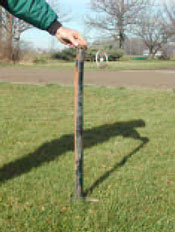 |
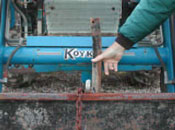 |
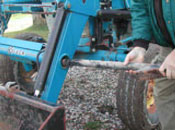 |
|
Figure 11. Loader’s bent
support stand |
Figure 12. Single central support location |
Figure 13. Location of support storage |
REFERENCES
MIFACE gratefully acknowledges the assistance of Peter Neilson, who provided
technical tractor information.
MIFACE (Michigan Fatality and Control Evaluation), Michigan State University (MSU) Occupational & Environmental Medicine, 117 West Fee Hall, East Lansing, Michigan 48824-1315. This information is for educational purposes only. This MIFACE report becomes public property upon publication and may be printed verbatim with credit to MSU. Reprinting cannot be used to endorse or advertise a commercial product or company. All rights reserved. MSU is an affirmative-action, equal opportunity employer. 2/23/04
To contact Michigan State FACE program personnel regarding State-based FACE reports, please use information listed on the Contact Sheet on the NIOSH FACE web site Please contact In-house FACE program personnel regarding In-house FACE reports and to gain assistance when State-FACE program personnel cannot be reached.
| To improve the quality of the MIFACE program and our investigation reports, we would like to ask you a few questions regarding this report. | |||
| Please rate the following on a scale of: | |||
| Excellent | Good | Fair | Poor |
| 1 | 2 | 3 | 4 |
| What was your general impression of this MIFACE investigation report? | |||
| Excellent | Good | Fair | Poor |
| 1 | 2 | 3 | 4 |
| Was the report… | Excellent | Good | Fair | Poor |
| Objective? | 1 | 2 | 3 | 4 |
| Clearly written? | 1 | 2 | 3 | 4 |
| Useful? | 1 | 2 | 3 | 4 |
| Were the recommendations … | Excellent | Good | Fair | Poor |
| Clearly written? | 1 | 2 | 3 | 4 |
| Practical? | 1 | 2 | 3 | 4 |
| Useful? | 1 | 2 | 3 | 4 |
| How will you use this report? (Check all that apply) | |
| O | Distribute to family members/employees |
| O | Post on bulletin board |
| O | Use in employee training |
| O | File for future reference |
| O | Will not use it |
| O | Other (specify) __________________________________________ |
Thank You!
Please Return To:
MIFACE
Michigan State University
117 West Fee Hall
East Lansing, MI 48824
FAX: 517-432-3606
Comments:
| If you would like to receive e-mail notifications of future MIFACE work-related fatality investigation report summaries, please complete the information below. | |
| Name: __________________________________________ | |
| e-mail address: ___________________________________ | |
| I would like to receive summaries for reports involving: | |
| ___ Construction | ___ Agriculture |
| ___ Manufacturing | ___ All |